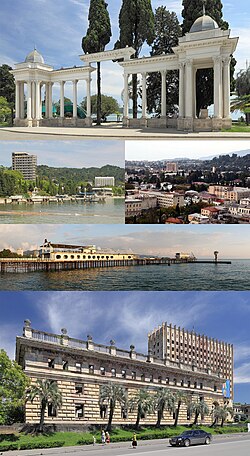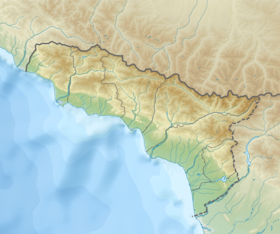Sukhumi
Sukhumi | ||
|---|---|---|
City | ||
 | ||
| ||
| Coordinates: 43°00′12″N 41°00′55″E | ||
| Country | Georgia | |
| Partially recognized state | Abkhazia[1] | |
| Settled | 6th century BC | |
| City Status | 1848 | |
| Government | ||
| • Mayor | Adgur Kharazia | |
| Area | ||
| • Total | 27 km2 (10 sq mi) | |
| Highest elevation | 140 m (460 ft) | |
| Lowest elevation | 5 m (16 ft) | |
| Population (2011) | ||
| • Total | 62,914 [2] | |
| Time zone | UTC+4 (MSK) | |
| Postal code | 384900 | |
| Area code | +7 840 22x-xx-xx | |
| Vehicle registration | ABH | |
Sukhumi or Sokhumi (Abkhazian: Аҟәа, Aqwa; Georgian: სოხუმი, [sɔxumi] (![]() listen); Russian: Сухум(и), Sukhum(i) [sʊˈxum(ʲɪ)]) is a city on the Black Sea coast. It is the capital of the breakaway Republic of Abkhazia which has controlled it since the 1992-93 war in Abkhazia, although most of the international community considers it legally part of Georgia.
listen); Russian: Сухум(и), Sukhum(i) [sʊˈxum(ʲɪ)]) is a city on the Black Sea coast. It is the capital of the breakaway Republic of Abkhazia which has controlled it since the 1992-93 war in Abkhazia, although most of the international community considers it legally part of Georgia.
Sukhumi's history can be traced back to the 6th century BC, when it was settled by Greeks, who named it Dioscurias. During this time and the subsequent Roman period, much of the city disappeared under the Black Sea. The city was named Tskhumi when it became part of the Kingdom of Abkhazia. Contested by local princes, it became part of the Ottoman Empire in the 1570s, where it remained until it was conquered by the Russian Empire in 1810. Following a period of conflict during the Russian Civil War, it became part of the Soviet Union, where it was regarded as a holiday resort. As the Soviet Union broke up in the early 1990s, the city suffered significant damage during the Georgian–Abkhazian conflict. The present-day population of 60,000 is only half of the population living there towards the end of Soviet rule.
Contents
Naming
In Georgian, the city is known as სოხუმი (Sokhumi) or აყუ (Aqu),[3] in Megrelian as აყუჯიხა (Aqujikha),[4] and in Russian as Сухум (Sukhum) or Сухуми (Sukhumi). The toponym Sokhumi derives from the Georgian word Tskhomi/Tskhumi, meaning beech.[citation needed] It is significant, that "dia" in several dialects of the Georgian language and among them in Megrelian means mother and "skuri" means water.[5] In Abkhaz, the city is known as Аҟәа (Aqwa) which according to native tradition signifies water.[6]
In the ancient Greek sources (Pseudo-Skilak of Kariand- IV c. B. C. ) the city is referred to as Dioscurias. According to the antique traditions this name originates from the mythical Dioskouri, the twin brothers Castor and Pollux, sons of Zeus. It was believed that the town had been established by Castor's and Pollux's coachmen, the Argonauts Telkius and Amphyst. However the names of the town may simply be the Greek comprehension of the old Georgian word combination.[citation needed]
The medieval Georgian sources knew the town as Tskhumi (ცხუმი).[7][8][9] Later, under the Ottoman control, the town was known in Turkish as Suhum-Kale, which can be derived from the earlier Georgian form Tskhumi or can be read to mean "water-sand fortress".[10][11] Tskhumi in turn is supposed to be derived from the Svan language word for "hot",[12] or the Georgian word for "hornbeam tree".
The ending -i in the above forms represents the Georgian nominative-suffix. The town was initially officially described in Russian as Сухум (Sukhum), until 16 August 1936 when this was changed to Сухуми (Sukhumi).[citation needed] This remained so until 4 December 1992, when the Supreme Council of Abkhazia restored the original version,[citation needed] that was approved in Russia in autumn 2008,[13] even though Сухуми is also still being used.
In English, the most common form today is Sukhumi, although Sokhumi is increasing in usage and has been adopted by sources including Encyclopædia Britannica,[14] MSN Encarta,[15] Esri[16] and Google Maps.[17]
General information
Sukhumi is located on a wide bay of the eastern coast of the Black Sea and serves as a port, rail junction and a holiday resort. It is known for its beaches, sanatoriums, mineral-water spas and semitropical climate. Sukhumi is also an important air link for Abkhazia as the Sukhumi Dranda Airport is located nearby the city. Sukhumi contains a number of small-to-medium size hotels serving chiefly the Russian tourists. Sukhumi botanical garden was established in 1840, one of the oldest botanical gardens in the Caucasus.
The city has a number of research institutes, the Abkhazian State University and the Sukhumi Open Institute. From 1945 to 1954 the city's electron physics laboratory was involved in the Soviet program to develop nuclear weapons.
The city is a member of the International Black Sea Club.[18]
History
The history of the city began in the mid-6th century BC when an earlier settlement of the second and early first millennia BC, frequented by local Colchian tribes, was replaced by the Milesian Greek colony of Dioscurias (Greek: Διοσκουριάς). The city is said to have been so named for the Dioscuri, the twins Castor and Pollux of classical mythology. It became busily engaged in the commerce between Greece and the indigenous tribes, importing wares from many parts of Greece, and exporting local salt and Caucasian timber, linen, and hemp. It was also a prime center of slave trade in Colchis.[19] The city and its surroundings were remarkable for the multitude of languages spoken in its bazaars.[20]
Although the sea made serious inroads upon the territory of Dioscurias, it continued to flourish until its conquest by Mithridates VI Eupator of Pontus in the later 2nd century. Under the Roman emperor Augustus the city assumed the name of Sebastopolis[21] (Greek: Σεβαστούπολις). But its prosperity was past, and in the 1st century Pliny the Elderdescribed the place as virtually deserted though the town still continued to exist during the times of Arrian in the 130s.[22] The remains of towers and walls of Sebastopolis have been found underwater; on land the lowest levels so far reached by archaeologists are of the 1st and 2nd centuries AD. According to Gregory of Nyssa there were Christians in the city in the late 4th century.[23] In 542 the Romans evacuated the town and demolished its citadel to prevent it from being captured by Sassanid Iran. In 565, however, the emperor Justinian I restored the fort and Sebastopolis continued to remain one of the Byzantine strongholds in Colchis until being sacked by the Arab conqueror Marwan II in 736.
Afterwards, the town came to be known as Tskhumi.[12] Restored by the kings of Abkhazia from the Arab devastation, it particularly flourished during the Georgian Golden Age in the 12th–13th centuries, when Tskhumi became a center of traffic with the European maritime powers, particularly with the Republic of Genoa. The Genoese established their short-lived trading factory at Tskhumi early in the 14th century. The city of Tskhumi became the summer residence of the Georgian kings. According to Russian scholar V. Sizov, it became an important “cultural and administrative center of the Georgian state.[24] Later Tskhumi served as capital of the Odishi — Megrelian rulers, it was in this city that Vamek I (c. 1384-1396), the most influential Dadiani, minted his coins.[25]
Documents of the 15th century clearly distinguished Tskhumi from Principality of Abkhazia.[26] The Ottoman navy occupied the town in 1451, but for a short time. Later contested between the princes of Abkhazia and Mingrelia, Tskhumi finally fell to the Turks in the 1570s. The new masters heavily fortified the town and called it Sohumkale, with kale meaning "fort" but the first part of the name of disputed origin. It may represent Turkish su, "water", and kum, "sand", but is more likely to be an alteration of its earlier Georgian name.[12]
At the request of the pro-Russian Abkhazian prince, the town was stormed by the Russian Marines in 1810 and turned, subsequently, into a major outpost in the North West Caucasus. (See Russian conquest of the Caucasus). Sukhumi was declared the seaport in 1847 and was directly annexed to the Russian Empire after the ruling Shervashidzeprincely dynasty was ousted by the Russian authorities in 1864. During the Russo-Turkish War, 1877–1878, the town was temporarily controlled by the Ottoman forces and Abkhaz-Adyghe rebels.
Following the Russian Revolution of 1917, the town and Abkhazia in general were engulfed in the chaos of the Russian Civil War. A short-lived Bolshevik government was suppressed in May 1918 and Sukhumi was incorporated into the Democratic Republic of Georgia as a residence of the autonomous People's Council of Abkhazia and the headquarters of the Georgian governor-general. The Red Army and the local revolutionaries took the city from the Georgian forces on 4 March 1921, and declared Soviet rule. Sukhumi functioned as the capital of the "Union treaty" Abkhaz Soviet Socialist Republic associated with the Georgian SSR from 1921 until 1931, when it became the capital of the Abkhazian Autonomous Soviet Socialist Republic within the Georgian SSR. By 1989, Sukhumi had 110,000 inhabitants and was one of the most prosperous cities of Georgia. Many holiday dachas for Soviet leaders were situated there.
Beginning with the 1989 riots, Sukhumi was a centre of the Georgian-Abkhaz conflict, and the city was severely damaged during the 1992–1993 War. During the war, the city and its environs suffered almost daily air strikes and artillery shelling, with heavy civilian casualties.[27] On 27 September 1993 the battle for Sukhumi was concluded by a full-scale campaign of ethnic cleansing against its majority Georgian population (see Sukhumi Massacre), including members of the pro-Georgian Abkhazian government (Zhiuli Shartava, Raul Eshba and others) and mayor of Sukhumi Guram Gabiskiria. Although the city has been relatively peaceful and partially rebuilt, it is still suffering the after-effects of the war, and it has not regained its earlier ethnic diversity. Its population in 2003 was 43,716, compared to about 120,000 in 1989.
'비잔틴제국' 카테고리의 다른 글
| <펌>Gothic War (535-554) (0) | 2019.11.26 |
|---|---|
| <펌>The Vlach, or the Origin of Romanians (0) | 2019.04.10 |
| <펌> Kelasuri Wall (Black Sea) (0) | 2019.02.05 |







